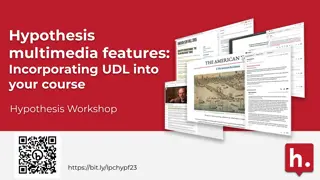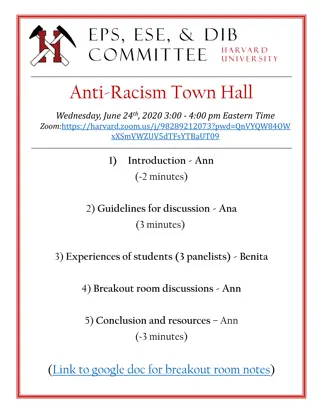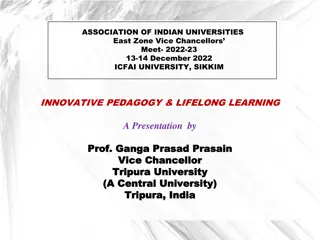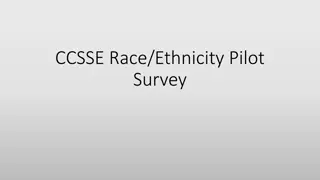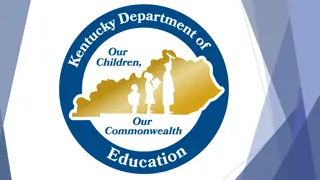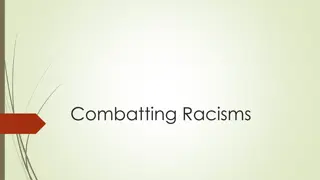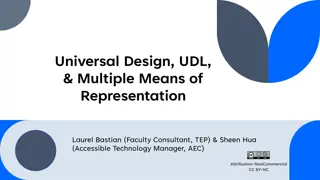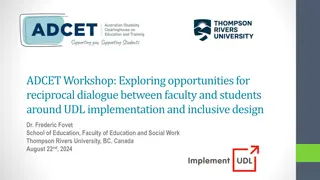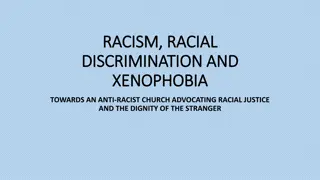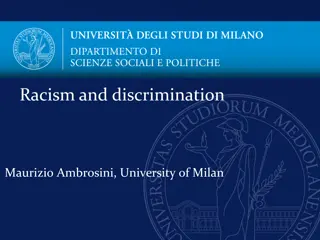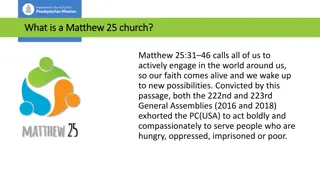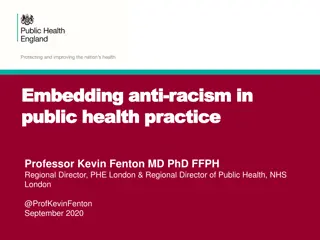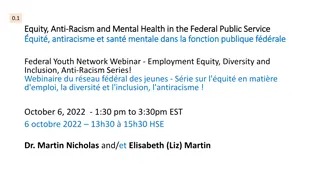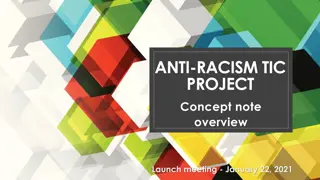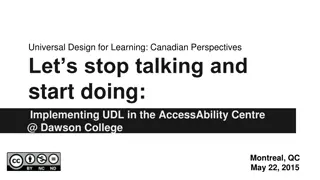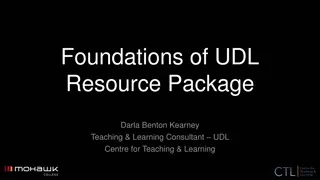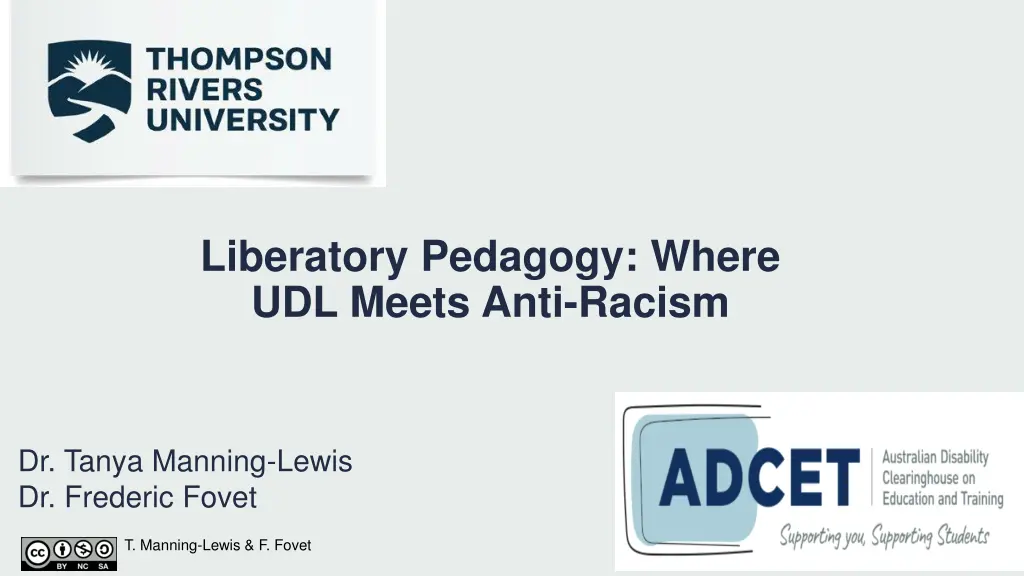
Liberatory Pedagogy in Education: UDL and Anti-Racism Intersection
Explore the intersection of Universal Design for Learning (UDL) and anti-racism in education, addressing race-neutral tendencies, challenges, and tangible strategies. Acknowledge the traditional custodians of the land and engage in discussions on race and Indigeneity.
Download Presentation

Please find below an Image/Link to download the presentation.
The content on the website is provided AS IS for your information and personal use only. It may not be sold, licensed, or shared on other websites without obtaining consent from the author. If you encounter any issues during the download, it is possible that the publisher has removed the file from their server.
You are allowed to download the files provided on this website for personal or commercial use, subject to the condition that they are used lawfully. All files are the property of their respective owners.
The content on the website is provided AS IS for your information and personal use only. It may not be sold, licensed, or shared on other websites without obtaining consent from the author.
E N D
Presentation Transcript
Liberatory Pedagogy: Where UDL Meets Anti-Racism Dr. Tanya Manning-Lewis Dr. Frederic Fovet T. Manning-Lewis & F. Fovet
Acknowledgment of Country We would like to acknowledge and pay respect to the Gadigal people of the Eora Nation, the traditional owners and custodians of the land on which the University of Sydney has been built, and which were taken from them without their consent, treaty or compensation. We pay respect to Elders past and present. This land has always been a learning space for many Aboriginal nations, and as teachers and students we can draw strength and guidance from Aboriginal and Torres Strait Islander knowledge, one of the oldest knowledge systems in the world. The University of Sydney acknowledges the traditional owners of this land (Sydney), the Gadigal people of the Eora nation. We stand on this land today as beneficiaries of an uncompensated and unreconciled dispossession that occurred over 200 years ago. 7/15/2025 2
Objectives? Goals Critically examine the race-neutral tendencies in dominant UDL discourses. Reflect on the tensions and challenges in merging UDL with anti- racist praxis. Explore tangible strategies that integrate UDL and anti-racist principles. Engage in collective problem-solving.
Challenging terminology Sensitive discussions It is important through this session to acknowledge, unpack, and clarify the way we interpret race In our Canadian context, there is some overlap but there are also considerable distinctions to be made between race and Indigeneity A complex landscape of intersectionality Acknowledging the North American continent s past in relation to slavery 7/15/2025 5
Introduction and Overview Provocation: What happens when access is defined without race in mind? Tensions in the field: Fear of addressing race under the guise of neutrality Instructors discomfort Institutional resistance
Introduction and Overview (Contd.) Provocation: Why has race remained thus far so tangibly absent from the UDL discourse? Historical dominance of accessibility services within the development of UDL Siloed nature of the work of student services and student affairs folks who support diverse learners Racial and socio-economic homogeneity of disability service provision Emergence of #disabilitytoo white since 2016 (Thompson, 2016) 7/15/2025 7
Pedagogical Praxis: Where UDL and Anti-racism Intersect In groups of 3 4, share Where do you see UDL initiatives intersecting with race in your context? Where does UDL fall short for racialized learners, whose needs or stories are overlooked? What tensions are you witnessing or experiencing? Where are you in this journey of integrating race into UDL? What questions or commitments are emerging for you? (Please share group thoughts on Padlet: https://edswgrad.padlet.org/ffovet1/pedagogical- praxis-where-udl-and-anti-racism-intersect-adcet-dfbdkhuz8jmi0fyf ) 7/15/2025 8
Pedagogical Praxis: Where UDL and Anti-racism Intersect QR Code for the Padlet 7/15/2025 9
Debrief on the activity UDL has fallen behind in relation to race because of an over-focus on impairment Intersectionality has been ignored in the last two decades by early UDL advocates and scholars CAST has acknowledged this delay and tried to address this in the UDL Guidelines 3.0. Whether this has been successful is moot. What remains tangible is that race is still not a central concern for many when using the UDL redesign process Current push back against EDI in the US under the current administration can only lead to more stagnation in this area 7/15/2025 10
Case Studies We will take 25 minutes to explore one of the case studies provided to you; please choose at your table a case study among the three listed. We hope that all case studies can be covered if possible we might ask the tables to coordinate that all cases studies are selected. Discuss it with your table for 25 minutes. We will debrief as a large room and will ask one participant from each table to summarize some of the discussions that took place. We will have a second Padlet available for you to archive your notes, or share in this manner if your table prefers: https://edswgrad.padlet.org/ffovet1/table-discussion- adcet-workshop-digital-backchannel-zlk41bdahbot7mth . Tanya and Frederic will circulate during your discussions and engage with the tables.
QR Code for the Padlet on which you are able to share your table discussions and archive your thoughts for the whole group 7/15/2025 12
Responding to Anti-racist UDL Needs In the post-secondary context, when using UDL consider: Race and specifically Blackness has been used to mark disability, while disability has inherently 'Blackened' those perceived as unfit. Black people were and continue to be assumed intellectually disabled precisely because of race (Bailey & Mobley, 2019, p.21). Intentionally include texts, voices, and media created by racialized scholars, artists, and activists as core content, not side notes. Make space for students to introduce examples from their cultural contexts or lived experiences (Much of the Black experience is shaped by an understanding of Black bodies as a productive labor force, leaving little room for an identity-based approach to disability, Bailey & Mobley, 2019) Humanize flexibility Utilize a trauma-informed pedagogy (Stigma complicates acknowledging Black disability, as it places an already precarious self at further risk of marginalization and vulnerability to state and medical violence, incarceration, and economic exploitation, Moore, 2017)
Responding to Anti-racist UDL Needs (Contd.) Disability Service Provision In the sphere of disability service provision, when supporting the growth of UDL: Acknowledge Acknowledge that learners lived experiences with UDL will radically diverge depending on race Acknowledge and seek Acknowledge and seek to challenge ways disability service provision has ignored dimensions of race Appreciate and factor in Appreciate and factor in the fact that UDL in the classroom may be less effective from the perspective of students who are racialized; they may be less receptive than peers Consider that UDL may not be seen as a priority by students and instructors concerned about race and equity Consider Understand that some educators may be approaching access in the classroom from the stance of critical race theory and not from a UDL perspective. Understand Consider how to reach instructors familiar with UDL to engage them about race and how to reach instructors whose primary lens is race to help them familiarize themselves with UDL Consider 7/15/2025 14
Actionable items We will take time to reflect what you see as the actionable item you wish to prioritize as you leave this workshop. We will use Menti to share and archive your planned action. Please open Menti.com on your device and we will generate a code for you to post the priority you are focusing on, as you leave our workshop. 7/15/2025 15
References Annamma, S. A., Ferri, B. A., & Connor, D. J. (2018). Disability critical race theory: Exploring the intersectional lineage, emergence, and potential futures of DisCrit in education. Review of Research in Education, 42(1), 46 71 Artiles, A. (2013). Untangling the racialization of disabilities: An intersectionality critique across disability models1. Du Bois Review: Cambridge, 10(2), 329 347. Bailey, M. (2017). Race and disability in the academy. The Sociological Review. https://www.thesociologicalreview.com/race-and-disability-in-the-academy/ Bailey, M., & Mobley, I. A. (2019). Work in the intersections: A Black feminist disability framework. Gender & Society, 33(1), 19 40. Baker, L. (2019). Normalizing marginality: A critical analysis of blackness and disability in higher education (Doctoral Thesis, Department of Social Justice Education, OntarioInstitute for Studies in Education, University of Toronto, Toronto, Canada). Retrievedfrom:https://tspace.library.utoronto.ca/bitstream/1807/95661/3/Baker_Leroy_201906_PhD_thesis.pdf (PDF) Bell, C. (Ed.). (2012). Blackness and disability: Critical examination and cultural interventions. State University Press. Bishop, D. (2018). More than just listening: The role of student voice in higher education, anacademic perspective. IMPact: The University of Lincoln Journal of Higher Education. 1 Blahovec, S. (2016, June 28) Confronting the whitewashing of disability: Interview with #DisabilityTooWhite Creator Vilissa Thompson. Huffington Post. https://www.huffingtonpost.com/sarah-blahovec/confronting-the-whitewash_b_10574994.htm (PDF) Frederick, A., & Shifrer, D. (2019). Race and disability: From analogy to intersectionality. Sociology of Race and Ethnicity, 5(2), 200 214 James, K. (2018) Universal design for learning (UDL) as a structure for culturally responsive practice. Northwest Journal of Teacher Education, 13(1), Article 4. Kendall, L., & Tarman, B. (Reviewing Ed.) (2016). Higher education and disability: Exploring student experiences. Cogent Education, 3(1) Kennette, L., & Wilson, N. (2019). Universal design for learning (UDL): Student and faculty perceptions. Journal of Effective Teaching in Higher Education, 2(1) (PDF)
References (contd.) Leary, A. (2017, June 14). Reflecting on the impact of #disabilitytoowhite. Rooted in Rights. https://rootedinrights.org/reflecting-on-the-impact-of-disabilitytoowhite/ (PDF) Mireles, D. (2022). Theorizing Racist Ableism in Higher Education. Teachers College Record, 124(7), 17-50. https://doi.org/10.1177/01614681221111428 Nolan, S. L. (2022). The compounded burden of being a black and disabled student during the age of COVID-19. Disability & Society, 1 6. https://doi.org/10.1080/09687599.2021.1916889 Shaw, L. R., Chan, F., & McMahon, B. T. (2012). Intersectionality and disability harassment: the interactive effects of disability, race, age, and gender. Rehabilitation Counseling Bulletin,55(2), 82 91S oorenian, A. (2013). Disabled international students in British higher education. Rotterdam, Sense Publishers Stanley, S. K., Buenavista, T., Masequesmay, G., & Uba, L. (2013). Enabling conversations: Critical pedagogy and the intersections of race and disability studies. Amerasia Journal,39(1), 75 82 (PDF) Tugli, A.K., Klu, E.K., & Morwe, K. (2014). Critical elements of the social model of disability:Implications for students with disabilities in a South African institution of higher education. Journal of Social Sciences, 39, 331 336. Velarde, M. (2018). Indigenous perspectives of disability. Disability Studies Quarterly, 38(4). https://dsq-sds.org/article/view/6114/5134 (PDF 7/15/2025 17
tmanninglewis@tru.ca ffovet@tru.ca

